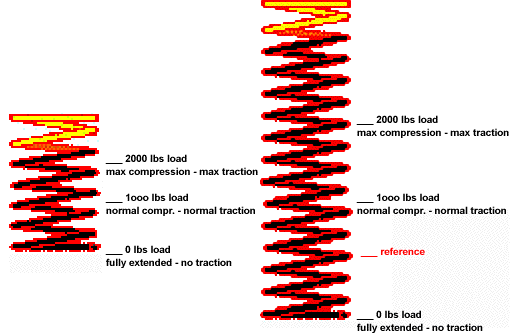@wittycranium
U R absolutely right, Wheel Travel is actually the Length of the Springs
Wheel Travel has a great influenc on Traction. For detail explanation. Let’s assume a vehicle weighs 4,000 lbs - that means each tire is pressed down with 1,000 lbs.
A spring will expand when it has to support less than 1/4 of the vehicle weight (ie when tire rolls into a small depression - Visually moving down and out of the fender well). As a result the other spring on the same axle will take over the extra load, and compresses more (visually that tire will move up into the fender well).
Since the traction is defined by specific friction, size of footprint and amount of weight, traction will be less when a spring expands - and more when a spring compresses, because an expanded spring does not press a tire as hard onto the ground as a compressed spring will.
Traction maximum is reached when a spring is fully compressed (now you know, why a bag of sand in the vehicle helps to improve traction) - the point of absolutely no traction is reached when a spring is fully extended. Therefore it is fair to say, that short springs (little wheel travel, usually on vehicles with independent suspension) will make a vehicle lose traction sooner than long springs (plenty of wheel travel, usually on vehicles with live axles).
This explains why vehicles with plenty of wheel travel (Range Rover, Jeep Grand Cherokee, Mercedes G-Class) maintain traction longer than vehicles with little wheel travel (M-Class). Unless some sort of traction management (traction control, 4ETS, etc) is present, a vehicle with less wheel travel will be stuck while the one with more wheel travel is still driving.
